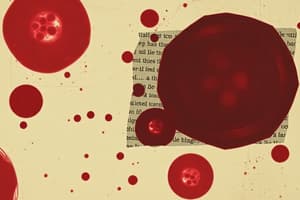Podcast
Questions and Answers
What percentage of the earth's crust is made up of Iron?
What percentage of the earth's crust is made up of Iron?
5.6%
Which group is at highest risk for Iron Deficiency?
Which group is at highest risk for Iron Deficiency?
- Infants
- Under 5 children
- Women of childbearing age
- All of the above (correct)
Iron deficiency is less common than Vitamin A deficiency.
Iron deficiency is less common than Vitamin A deficiency.
False (B)
What are the two types of iron found in the diet?
What are the two types of iron found in the diet?
_____ is the major protein responsible for transporting iron in the body.
_____ is the major protein responsible for transporting iron in the body.
What is the normal hemoglobin cutoff point for diagnosing anemia?
What is the normal hemoglobin cutoff point for diagnosing anemia?
Which of the following can inhibit iron absorption?
Which of the following can inhibit iron absorption?
What factors can increase non-haem iron absorption?
What factors can increase non-haem iron absorption?
What is one of the possible causes of chronic iron deficiency?
What is one of the possible causes of chronic iron deficiency?
Flashcards are hidden until you start studying
Study Notes
Iron in Nature
- Iron constitutes 5.6% of the earth's crust, making it the fourth most abundant element after Oxygen, Silicon, and Aluminum.
- Present in soil at levels 100 times greater than Calcium, Sodium, and Magnesium, and significantly more than Zinc and Iodine.
Iron Deficiency
- Most prevalent micronutrient deficiency globally, affecting 1.3 billion people (approximately 24% of the world population).
- Compared to iron deficiency, only 275 million have iodine deficiency, and 45 million children under 5 are vitamin A deficient.
- Primary cause of anemia worldwide, linked to chronic health issues and possible indicators of underlying diseases such as tumors.
- Anemia is defined as hemoglobin levels below the 5th percentile of healthy populations, with a common cutoff around 11 g/dl.
At-Risk Groups
- Infants, children under 5 years, school-aged children, and women of childbearing age are at higher risk for iron deficiency.
Prevalence of Iron Deficiency
- South Asia: 56% (0-4 years), 50% (5-12 years), 58% (women)
- Africa: 56% (0-4 years), 49% (5-12 years), 44% (women)
- Latin America: 26% (0-4 years), 26% (5-12 years), 17% (women)
- Gulf Arabs: 40% (0-4 years), 36% (5-12 years), 38% (women)
- Developed countries: 12% (0-4 years), 7% (5-12 years), 11% (women)
- Global averages: 43% (0-4 years), 37% (5-12 years), 35% (women)
Etiology of Iron Deficiency
- Inadequate dietary intake and consumption of foods that enhance absorption or inhibit it.
- Hookworm infestations, heavy menstrual bleeding, gastrointestinal bleeding, and high fertility rates contribute to deficiency.
- Newborns may have low iron stores, necessitating attention.
Dietary Iron
- Two forms: Hem iron (from animal sources like meat) and Non-haem iron (from plant sources like cereals and vegetables).
- Milk is a poor source of iron; breastfed infants may require supplements.
Iron Absorption
- Hem iron absorption ranges from 20-30%, largely unaffected by other dietary components.
- Non-haem iron absorption varies (2%-100%) and is influenced by body's iron status, solubility of iron compounds, gut health, and presence of absorption inhibitors.
Inhibitors of Iron Absorption
- Foods with polyphenols: tea, coffee, cocoa, and certain cereals/vegetables can significantly reduce iron absorption.
- Phytic acid-rich foods: bran, some legumes, and whole grains bind iron and decrease its availability.
- Cow's milk inhibits absorption due to high calcium and casein content.
Promoters of Iron Absorption
- Ascorbic acid-rich foods (e.g., citrus fruits, broccoli) enhance non-haem iron absorption by converting it to more absorbable forms.
- Muscle proteins help absorb iron by releasing peptides that facilitate the transformation of ferric to ferrous iron.
Iron Transport and Storage
- Transferrin is the primary protein for transporting iron, binding to transferrin receptors on body cells.
- Higher transferrin receptor concentrations in iron-demanding tissues (e.g., liver, bone marrow) indicate a need for iron.
- Iron is stored as ferritin and hemosiderin in the liver and bone marrow; ferritin levels help assess iron stores.
Role of Iron in the Body
- Essential for various physiological functions, primarily as an oxygen carrier in hemoglobin.
Studying That Suits You
Use AI to generate personalized quizzes and flashcards to suit your learning preferences.




